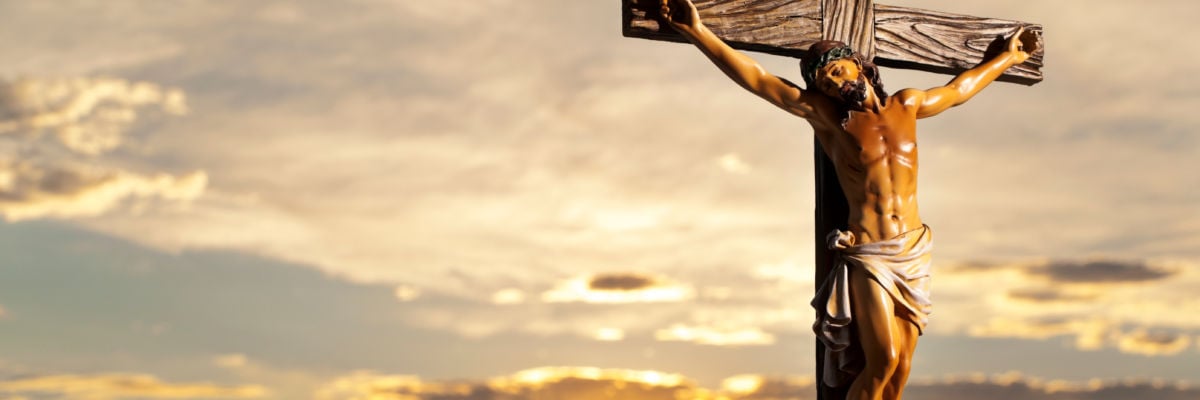
During my time in North Carolina, I remember having a conversation with a woman in the Episcopal parish I was attending. She was expressing her delight at a certain processional cross that lacked a body. What she was happy about was exactly the fact that it was a cross, not a crucifix—no crucified body hanging there to distract us from the symbolism. “We are,” she told me, “a resurrection church.”
I’m not sure if that meant what she thought it meant. I did grow up in the South, where the Baptists would often accuse Catholics of wanting to leave Jesus on the cross, and far be it from me to denigrate an emphasis on the resurrection of our Lord. But here’s what I don’t get: you can’t have a resurrection if you don’t have a death, and if we’re not supposed to linger over the death of Jesus, why have a cross at all? Sure, it might be a little less morbid to look at an instrument of torture and execution without the grisly dying body attached to it, but it’s hardly a sanitary, inoffensive thing on its own. At least it wouldn’t have been so in the early centuries of the Church. For them, displaying a cross, however bare, would have been like displaying an electric chair, or a guillotine, or a noose.
In a similar way, I’ve always found it interesting that in the major iconoclastic controversies of the first millennium, the cross was almost always the non-controversial thing. In the eighth century, people went around smashing the images of Jesus and the saints, but they didn’t tear down crosses. Sometimes they even put up crosses in place of the old icons. And this fit with the theology: the cross was not an image, an icon, of a person; the cross was just a symbol that pointed to something else. You could put up a cross, thought the iconoclasts, as a symbol of the Passion without leading to idolatry. Because it was always clear that the object of devotion was not the cross, but the one who suffered and died on the cross.
Now, if you think that’s nonsense, you have on your side both the eighth-century defenders of images and the Protestant iconoclasts of the sixteenth century. For both, the assumption was that either earthly, material objects were useful in Christian worship or not. It’s all or nothing. And so the orthodox party in the eighth century defended all kinds of material devotion—symbols, sacraments, icons, relics—whereas some later Reformers rejected them all, including even the bare cross. Probably you’ve seen pictures of, or visited, the whitewashed Puritan meeting houses of New England, and that stripped down style remains the ideal in not a few churches.
I think we can understand why the idea is appealing. It is a very modern approach. The assumption is that if we can strip back all the layers of tradition and dogma and superstition, we can find the deep truth underneath. We want to get under the surface, behind appearances. And so religious images can seem, to the modern mind, inherently sinister, because they presume to be something on their own. They call our attention to the appearance of things rather than to the truth behind appearances.
In one way, the Tradition affirms this. The cross is, really, an accidental symbol; it just happens to be the way that Jesus died. It is a better symbol for its connection with other scriptural symbols—the tree in the garden, the wood of the Ark, etc.—but in the end, it was merely a vehicle for the important thing: the sacrifice of Christ for the sins of the world.
And yet today’s feast, Holy Cross Day, is first and foremost not about the Passion. It is not about the crucifixion and the suffering of the Lord, except in an indirect way. It is about the location of that suffering and passion, about the physical residue of it: it’s about the cross. September 14 commemorates not Good Friday, but the presentation of the True Cross outside the newly built Church of the Holy Sepulcher in 335.
The full traditional name of this feast is the Triumph of the Cross, or the Exaltation of the Holy Cross. Every day in the Mass, and every year in the liturgy of Good Friday, we call attention to what happened on the cross, but today the focus is on the cross itself.
What Holy Church asks us to do, this day, is not to try to get behind the cross; the Church asks us first not to contemplate its intellectual significance, its symbolic weight, but to look at this simple object. Dozens of crosses stand in almost any Catholic church—at the altar, in the processional cross, on the pews, in the windows. Our task is first to look, to see. The reading from Numbers, referenced by our Lord himself in John, makes this act of looking central: “Moses accordingly made a bronze serpent and mounted it on a pole, and whenever anyone who had been bitten by a serpent looked at the bronze serpent, he lived.” “Just as Moses lifted up the serpent in the desert, so must the Son of Man be lifted up.” So that we can look at him and believe.
And then, remembering our crucified Lord, we are asked to “take up our cross.”
We heard this just last week in the Sunday Gospel in reference to the cost of discipleship, the potential alienation from family and friends that might come from following Jesus. It remains an odd thing to say, especially if we bring it to bear on Holy Cross Day and the exaltation of the True Cross. The whole point of the Holy Cross is its uniqueness, its particularity—as the hymn proclaims, “faithful cross above all other, one and only noble tree.” Its value cannot be generalized. Though there are many small fragments of the True Cross in the world, surely walking around with one of those fragments is not central to ordinary discipleship.
What, then, is our cross?
I do not think it means, in the first instance, our own personal suffering, though this is an implication that can and should come later. I think the first meaning of “taking up our cross” is quite literal: it means that we have permission to use the cross as a sign—to put it in our churches and in our homes and on our persons—to make, as Christians have done from the very beginning, the sign of the cross, over ourselves, over each other, over all creation. Following ancient tradition, we make the sign of the cross on the head of the every baptismal candidate, as one of the more famous cross hymns reminds us: “Each newborn soldier of the crucified, bears on the brow the sign of him who died.”
Some of us cross ourselves more, some less; some before meals, some before communion, or after; some in private, some in public; some in anxiety, some in calm. There is freedom here, not necessity: the freedom to claim the sign as our own, to “take it up” in response to Jesus.
It is a ritual, to be sure: a rote gesture, a repetition, not a magical formula. It may appear that way at times—in the traditional Roman Rite, the priest makes the sign of the cross over fifty times in the course of the Mass. I do this without thinking about it, as I was trained. And that is part of the point: to step back from my personality and my preference and enter a world in which the cross looms larger than my intentions, larger than my prejudices, larger than my limitations, larger than I want or am capable of. This unique, unrepeatable, physical thing, the wood of the cross, the shape of the cross, is meant to break our world of signs and symbols just as it broke the body of the Word of God.
The cross is the sign of new creation, but it also is the new creation, because it is a sign and a symbol of death—of the most horrible and painful and dehumanizing death—that has been seized by God and forged into a means—not just a symbol, but an actual means—of life. Whatever shape the cross takes—with or without the crucified body, in plain wood, or stone, or brass or gold encrusted with jewels—in physical gesture, there can be no getting behind it, no uncovering its true meaning, because the cross is always already its own true meaning. It is always already something that it is not: both death and life. Though the cross has, as G.K. Chesterton put it, “at its heart a collision and a contradiction, [it] can extend its four arms for ever without altering its shape. Because it has a paradox in its center, it can grow without changing.”
To sign ourselves with the cross, then, is to declare that there is nothing more meaningful behind this hand, this mind, this body, these arms that renders them unnecessary or accidental or mere vessels or symbols—no gnostic story that frees us from responsibility or lets us escape the God whose love death could not contain. It is to declare that this material stuff can be, in the power of God, meaningful and useful, not just as the symbol of something else more interesting, but as the transformative life of the new creation. And it is also to declare that there is no getting away from the cross, from the bloody details of history, from the countless moments where God meets us and insists on his love for us. It is in those moments, those details, and in that sign of wood and iron, that God gives us life.
“Behold the wood of the Cross, on which was hung the world’s salvation. O come, let us worship!”



